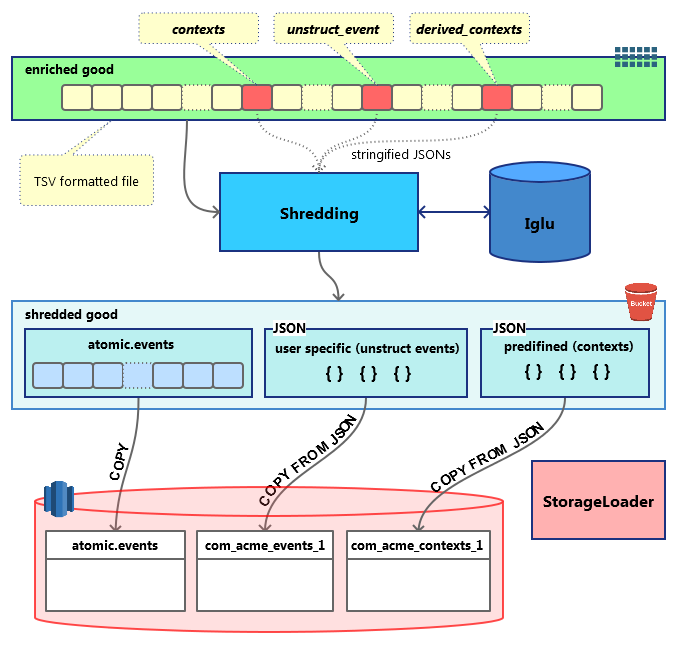Transforming enriched data
For a high-level overview of the RDB Loader architecture, of which the transformer is a part, see RDB Loader.
The transformer application can have two types of output:
- 'shredded' data
- wide row format.
Both the Spark transformer and the stream transformer can output both types. Which type to pick, depends on the intended storage target.
For loading into Redshift, use shredded data.
For loading into Snowflake, use wide row format.
For loading into Databricks, use wide row format.
Shredded data#
Shredding is the process of splitting a Snowplow enriched event into several smaller chunks, which can be inserted directly into Redshift tables.
A Snowplow enriched event is a 131-column tsv line. Each line contains all fields that constitute a specific event, including its id, timestamps, custom and derived contexts, etc.
After shredding, the following entities are split out from the original event:
- Atomic event. A tsv line very similar to the enriched event but not containing JSON fields (
contexts,derived_contextsandunstruct_event). The results are stored under a path similar toshredded/good/run=2016-11-26-21-48-42/atomic-events/part-00000and are available to load with RDB Loader or directly with RedshiftCOPY. - Contexts. Two JSON fields --
contextsandderived_contexts-- are extracted from the enriched event. Their original values are validated self-describing JSONs, consisting of aschemaand adataproperty. After shredding, a third property is added, calledhierarchy. Thishierarchycontains fields you can use to later join your context SQL tables with theatomic.eventstable. One atomic event can be associated with multiple context entities. The results are stored under a path likeshredded/good/run=2016-11-26-21-48-42/shredded-types/vendor=com.acme/name=my_context/format=jsonschema/version=1-0-1/part-00000, where thepart-*files are valid ndJSON files which can be loaded with RDB Loader or directly with RedshiftCOPY. - Self-describing (unstructured) events. Same as the contexts described above but there is a strict one-to-one relation with atomic events. The results are stored under a path with the same structure as for contexts and are ready to be loaded with RDB Loader or directly with Redshift
COPY.
These files are stored on S3 partitioned by type. When the data is loaded into Redshift, each type goes to a dedicated table.
The following diagram illustrates the process:

NOTE: Shredded data can currently only be loaded into Redshift.
Wide row format#
Unlike shredding, wide row format preserves data as a single line per event, with one column for each different type of contexts and self-describing events.
For contexts (aka entities), the type of the column is ARRAY and the name looks like contexts_com_acme_my_custom_entity_schema_1. Note the plural that matches the ARRAY type: in theory each contexts_* column may contain multiple entities.
For self-describing events, the type of the column is OBJECT and the name looks like unstruct_event_com_acme_my_custom_event_schema_1. Each line in the table contains only 1 event.
The values in these columns have recursive structure with arbitrary depth, which depends on the schema that describes them.
The results are stored under a path like output=good/part-00000 and can be loaded with RDB Loader.
There are two options as output file format with wide row transformation: JSON and Parquet
JSON file format can be used for loading into Snowflake and Parquet file format can be used for loading into Databricks